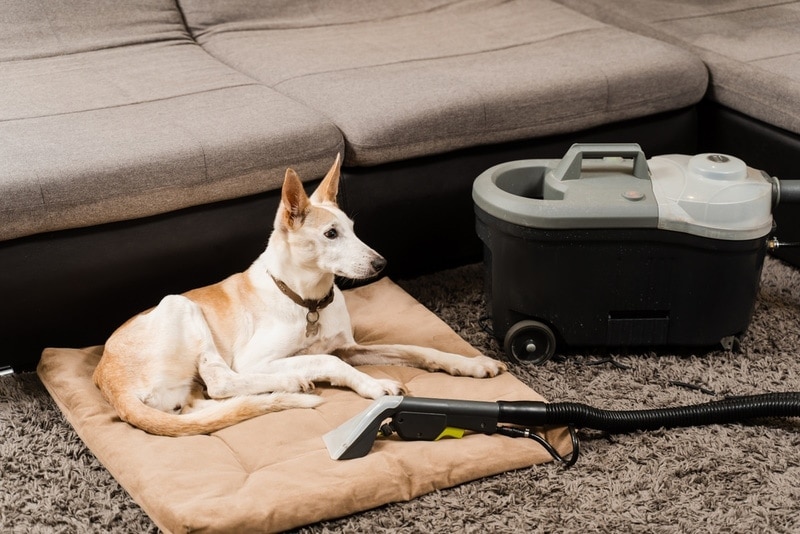Flyball for Dogs 101: Info, Guide & How to Get Started

Updated on
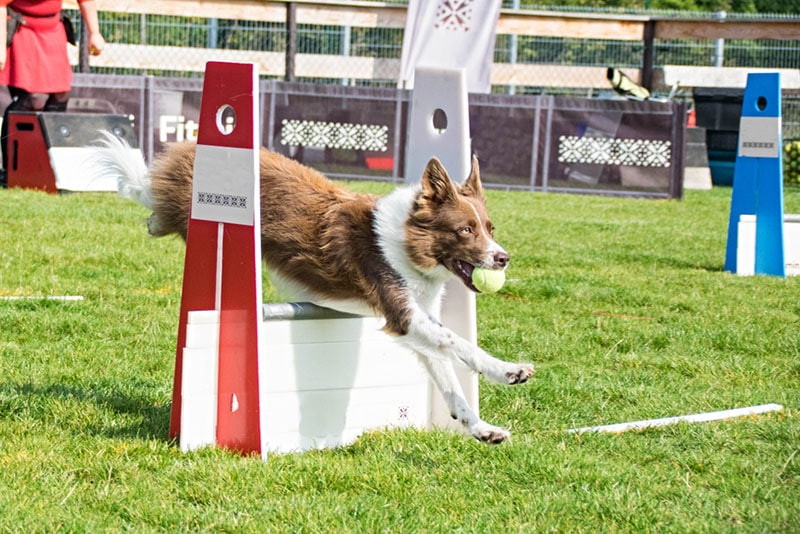
Flyball is one of the most interesting and fast-paced sports in the world, and if you ever stumble upon it without a clue what it is, it’s hard to pick up on. Fortunately, if someone walks you through it all step-by-step, it’s pretty easy to pick up.
That’s exactly what we’re going to do here. We’ll walk you through everything you need to know about the sport of flyball. It might seem like a lot to dive into, but it’s fairly simple, and once you get the hang of it, it’s a ton of fun!
How Does It Work?
Flyball is a fast-paced sport with a ton of action. Each flyball team consists of four handlers and four dogs, and each team will typically have two backup handlers and backup dogs just in case something happens to one of the primary team members.
There are four hurdles between 7 and 14 inches high (the hurdle’s exact height depends on the team’s smallest dog). The hurdles are 10 feet away from each other, the first hurdle is 6 feet from the starting line, and the flyball box is 15 feet after the last hurdle, making a 51-foot course.
Dogs go one at a time and must jump over each hurdle. The dog activates the flyball box which sends the ball into the air. The dog must catch the ball in the air and then jump over all the hurdles. Once the dog crosses the starting line the next dog can go.
If a dog misses a hurdle or misses the ball when it’s in the air, that dog must rerun the course after the other dogs finish. The first team to have all four dogs successfully complete the relay wins the match!
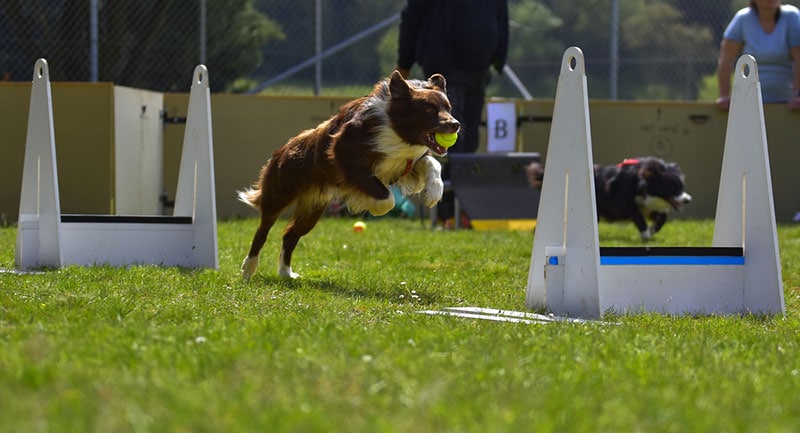
What Are the Different Types of Flyball?
While flyball is the same no matter which league you go with, there are a variety of flyball leagues you and your dog can join. Three of the largest leagues in the North American Flyball Association (NAFA) are the Flyball Dog Champion (FDCH), Flyball Master (FM), and ONYX.
But while these are the largest professional flyball leagues out there, there are plenty of other smaller flyball leagues you can try to get your dog into.
Keep in mind when selecting a flyball league that most dogs don’t have what it takes to make it to the professional ranks, so it’s a better idea to try and find a league where you and your dog can have fun! For reference, the fastest flyball time of all time is just 14.333 seconds, which means each dog completed the entire course in just over 3.5 seconds!
With flyball, you supply your own balls and flyball box, so there is a slight variation, but the balls and box must meet regulatory requirements for the league you’re in.
Where Do Teams Play Flyball?
While flyball might not have the same following as other major sports, you can find people playing flyball all over the world. The largest flyball organizations are in North America competing in the United States and Canada, but you can also find flyball teams on other continents.
Currently, the most active flyball countries include Britain, Belgium, Australia, Italy, The Netherlands, Switzerland, Austria, and Germany, in addition to the aforementioned United States and Canada.
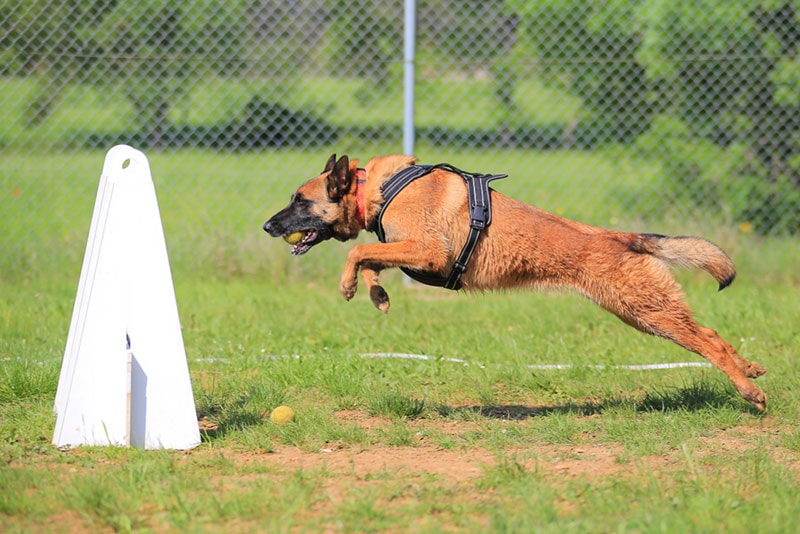
Advantages of Flyball
One of the best parts about flyball is that it’s a great bonding activity for dogs and their owners. Not only that, but there are no breed restrictions, and even mixed breeds can happily play the sport. This makes it a non-exclusive club.
As long as your dog is fine around other dogs, is active, listens to voice commands, and has a strong recall, there’s no reason they can’t play flyball. Even if they’re not the best, it’s an excellent way for them to spend some time with you and get some exercise in the process!
Disadvantages of Flyball
While there’s plenty to love about flyball, it’s not perfect. For starters, for non-athletic dogs, it’s not the easiest for them to compete. It doesn’t matter how well they listen, if they’re not fast, flyball isn’t for them.
Not only that but with tons of hurdles and sharp turns, injuries while playing flyball are relatively common. If you plan on getting your dog into flyball, we highly recommend setting them up with a pet insurance plan so you can treat any injuries that come up without spending a ton on vet bills.
Frequently Asked Questions (FAQs)
Flyball is an extremely interesting sport, and the more you learn about it the more you want to know. We understand the fascination, and it’s why we decided to answer some of the most frequently asked questions for you here.
What Age Can Dogs Play Flyball?
Any dog that’s older than 15 months can play flyball. This gives their bodies time to fully develop before putting them on a track with other high-energy dogs. Once a dog is older than 15 months they can play for as long as they can keep up!
What Breed Is Best for Flyball?
While there’s no singular “best breed” for flyball, some breeds certainly do better than others. Some of the best breeds for flyball include border collies, terriers, retrievers, shepherds, whippets, or any combination of those breeds. Remember, mixed breeds can play flyball too!
Why Do Flyball Dogs Wear Bandages?
The bandages dogs wear during flyball help with circulation and ensure their pads can dry out after a race. Dogs sweat through their pads, and handlers don’t want them sliding all over the course while they’re running their race!
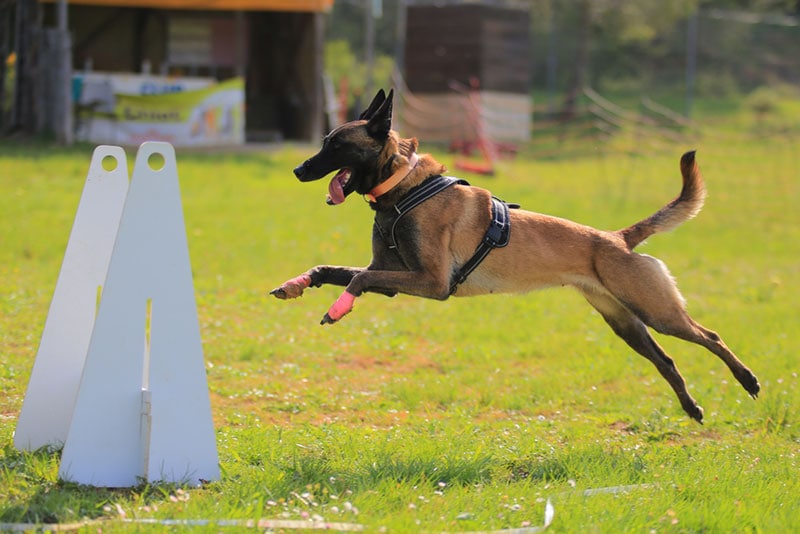
How Do You Train a Dog to Play Flyball?
Training a dog to play flyball is much like training a dog to do anything else. You’ll need to teach them to release a ball from a flyball box, and you’ll need to teach them to jump over hurdles. Reward them when they listen, stay positive, and stay consistent. If you do these things, you can properly train a dog to play flyball in no time.
How High Are the Hurdles in Flyball?
The hurdles in flyball are set 4 inches below the smallest dog (at the withers) on a flyball team. However, the minimum height for a hurdle is 7 inches, and hurdles cannot go larger than 14 inches. This means teams competing against each other will likely have hurdles set to different heights depending on the size of the dogs on their team.
Conclusion
Now that you know a little more about flyball, all that’s left is to see if there are any leagues in your area and start training your dog. Once you and your pup get the hang of things, you can find a team and get your feet wet in the fast-paced world of flyball.
Proceed with caution, though. Once you and your pup start playing flyball, you won’t want to stop!
Featured Image Credit: dodafoto, Shutterstock



